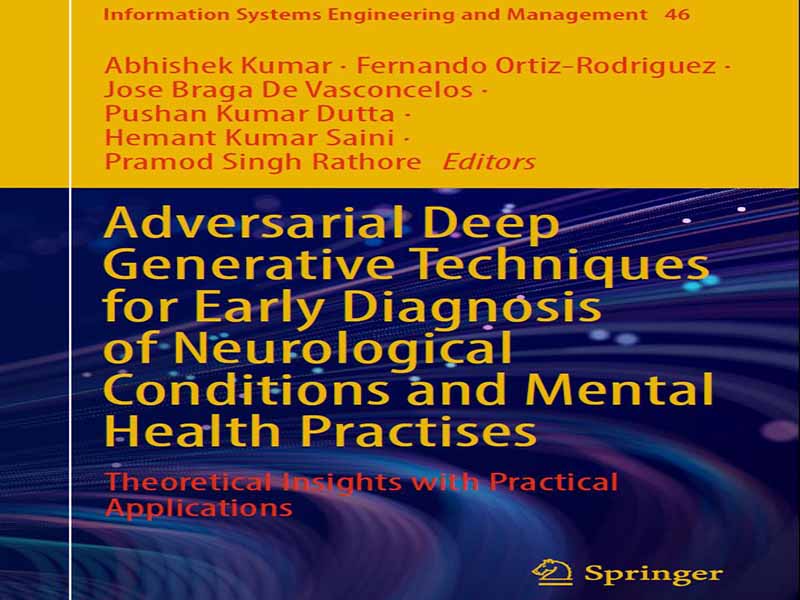- عنوان کتاب: Adversarial Deep Generative Techniques for Early Diagnosis of Neurological Conditions and Mental Health Practises
- نویسنده: Abhishek Kumar, Fernando Ortiz-Rodriguez
- حوزه: یادگیری عمیق
- سال انتشار: 2025
- تعداد صفحه: 411
- زبان اصلی: انگلیسی
- نوع فایل: pdf
- حجم فایل: 5.06 مگابایت
در تقاطع هوش مصنوعی و مراقبتهای بهداشتی، یک مرز انقلابی نهفته است که نویدبخش تحول در عمل بالینی در مغز و اعصاب و روانپزشکی است. این کتاب، تکنیکهای مولد عمیق تخاصمی برای تشخیص زودهنگام بیماریهای عصبی و شیوههای سلامت روان، ابزارهای عملی را در اختیار پزشکان قرار میدهد که میتوانند در مراقبت روزانه از بیمار ادغام شوند تا دقت تشخیصی و برنامهریزی درمان را به طرز چشمگیری بهبود بخشند. بخشهای زیر مروری بر مفاهیم کلیدی، روشها، کاربردهای بالینی، یافتههای تحقیقاتی، ملاحظات اخلاقی، پیادهسازیهای فنی و جهتگیریهای آینده ارائه میدهند که در مجموع موضوع اصلی این جلد را تشکیل میدهند. مطالعه ما نکات زیر را برجسته میکند: تکنیکهای مولد تخاصمی: پیادهسازی شبکههای مولد تخاصمی برای ترکیب تصاویر پزشکی، بهبود آموزش مدل در سناریوهای کمبود داده و اصلاح وظایف طبقهبندی. خطوط لوله تقسیمبندی و طبقهبندی: استفاده از شبکههای عصبی تخصصی (به عنوان مثال، انواع U-Net، چارچوبهای یادگیری انتقالی، خوشهبندی مبتنی بر گراف) برای تقسیمبندی نواحی مغز و طبقهبندی حالات بیماری. رویکردهای پیشرفته یادگیری عمیق: استفاده از شبکههای عصبی گراف (GNN)، شبکههای عصبی کانولوشن (CNN) و ترانسفورماتورها برای مدیریت دادههای پیچیده و با ابعاد بالا برای تشخیص زودهنگام بیماری و درمان شخصیسازیشده. ارزیابیهای صدا و رفتار: ادغام تحلیل گفتار و سایر سیگنالهای بالینی برای پشتیبانی از تشخیص بیماری پارکینسون، اختلالات خلقی و اختلالات اضطرابی با استفاده از یادگیری ماشین و یادگیری عمیق. تحلیل متنی و احساسی: کاربرد تکنیکهای پیشرفته NLP برای تشخیص الگوهای سلامت روان در ارتباطات مبتنی بر متن، کمک به استراتژیهای مداخله زودهنگام. این مجموعه با مقدمهای ضروری در مورد دستیاران مجازی هوش مصنوعی در مراقبتهای بهداشتی روان (فصل «دستیار مجازی هوش مصنوعی در مراقبتهای بهداشتی روان») آغاز میشود و به پزشکان بینش فوری در مورد چگونگی کاهش بار اداری توسط این فناوریها و در عین حال افزایش غربالگری بیمار ارائه میدهد. استفادهکنندگان اولیه گزارش میدهند که 5 تا 7 ساعت در هفته در مستندسازی صرفهجویی میکنند و زمان تماس مستقیم بیشتری با بیمار دارند. برای متخصصان مغز و اعصاب و رادیولوژیستها، فصلهای «تشخیص بیماری آلزایمر مبتنی بر تصویربرداری عصبی از طریق قطعهبندی با طبقهبندی با استفاده از الگوریتمهای یادگیری ماشین» – «طبقهبندی اختلال روانی با مدلهای مولد عمیق» تکنیکهای تشخیص آلزایمر را با دقت قابل توجه ۹۵ تا ۹۸ درصد در مراحل قبل از بروز علائم، بلافاصله ارائه میدهند. این فصلها شامل راهنماهای پیادهسازی گام به گام و مطالعات موردی از مراکز پزشکی پیشرو هستند که در آنها زمانبندی تشخیص از ماهها به روزها کاهش یافته است. چارچوبهای مبتنی بر CNN شرح داده شده بر روی تجهیزات استاندارد تصویربرداری عصبی که در حال حاضر در اکثر محیطهای بالینی موجود است، اعتبارسنجی شدهاند. روانپزشکان ارزش ویژهای را در فصل «حسگر بدون تماس انسان با استفاده از سیگنالهای بیسیم برای مراقبتهای زیستپزشکی و بهداشتی شخصیسازی شده» خواهند یافت. فناوریهای حسگر بدون تماس انسان، که ۸۷ درصد دقت در تشخیص اضطراب و افسردگی در طول ویزیتهای معمول مطب بدون بار اضافی برای بیمار نشان دادهاند. فصل «انقلابی در مراقبتهای سلامت روان با تکنیکهای یادگیری عمیق مولد برای تشخیص و درمان پیشرفته» این موضوع را با مدلهای مولد برای تشخیص روانپزشکی گسترش میدهد که در موارد دارای بیماریهای همراه، نویدبخش بودهاند و میزان تشخیص اشتباه را در آزمایشهای بالینی ۶۲٪ کاهش دادهاند. فصل «استفاده از XRAI برای تشخیص و مکانیابی تومور مغزی قابل تفسیر» تکنیکهای تشخیص تومور مغزی قابل تفسیر با استفاده از XRAI را در اختیار متخصصان مغز و اعصاب و انکولوژیستها قرار میدهد، که اعتبارسنجی بالینی آن دقت ۹۱٪ را در تشخیص انواع تومور از توالیهای استاندارد MRI نشان میدهد. چندین جراح مغز و اعصاب شاغل، مطالعات موردی ارائه دادهاند که نشان میدهد چگونه این ابزارها بر برنامهریزی جراحی و بهبود نتایج تأثیر میگذارند. شاید ارزشمندترین بخش برای پزشکان پرمشغله، فصل «پیادهسازی و ادغام عملی هوش مصنوعی در مراقبتهای سلامت روان» باشد. چارچوب عملی ادغام هوش مصنوعی که با همکاری سیستمهای بیمارستانی که این فناوریها را با موفقیت پیادهسازی کردهاند، توسعه یافته است. این فصل شامل راهنماییهای عملی در مورد ادغام گردش کار، آموزش کارکنان و استراتژیهای بازپرداخت است که توسط ارائه دهندگان اصلی بیمه تأیید شده است. تکنیکهای ارزیابی مبتنی بر صدا برای بیماری پارکینسون که در فصل «مروری جامع بر تکنیکهای مولد عمیق در مطالعه و مدیریت اختلالات عصبی» به تفصیل شرح داده شده است، به متخصصان مغز و اعصاب یک ابزار تشخیصی غیرتهاجمی و کمهزینه ارائه میدهد که میتواند از طریق برنامههای تلفن هوشمند در طول ویزیتهای معمول بیمار به کار گرفته شود. مطالعات اعتبارسنجی بالینی، تطابق ۸۹ درصدی با روشهای تشخیصی سنتی را نشان میدهد، در حالی که با شناسایی تغییرات ظریف الگوی صدا ۶ تا ۱۸ ماه قبل از بروز علائم حرکتی قابل مشاهده، امکان تشخیص زودهنگام را فراهم میکند. این کتاب بر پیشرفتهای قابل توجه در مدلهای مولد عمیق و رقابتی برای مقابله با چالشهای حیاتی در حوزه سلامت روان و اعصاب تأکید میکند.
At the intersection of artificial intelligence and healthcare lies a revolutionary frontier that promises to transform clinical practice in neurology and psychiatry. This book, Adversarial Deep Generative Techniques for Early Diagnosis of Neurological Conditions and Mental Health Practices, offers clinicians practical tools that can be integrated into daily patient care to dramatically improve diagnostic accuracy and treatment planning. The following sections provide an overview of key concepts, methodologies, clinical applications, research findings, ethical considerations, technical implementations, and future directions that collectively frame the central theme of this volume. Our study highlights the following points Generative Adversarial Techniques: Implementation of GANs for synthesizing medical images, improving model training in data-scarce scenarios, and refining classification tasks. Segmentation and Classification Pipelines: Employing specialized neural networks (e.g., U-Net variants, transfer learning frameworks, graph-based clustering) to segment brain regions and classify disease states. Advanced Deep Learning Approaches: Use of Graph Neural Networks (GNNs), Convolutional Neural Networks (CNNs), and Transformers to handle complex, high-dimensional data for early disease detection and personalized treatment. Voice and Behavioral Assessments: Integration of speech analysis and other clinical signals to support the diagnosis of Parkinson’s disease, mood disorders, and anxiety disorders using both machine learning and deep learning. Textual and Sentiment Analysis: Application of advanced NLP techniques to detect mental health patterns in text-based communications, aiding in early intervention strategies. The collection begins with an essential introduction to virtual AI assistants in mental healthcare (Chapter “Virtual AI Assistant AI in Mental Healthcare”), providing clinicians with immediate insights into how these technologies can reduce administrative burden while enhancing patient screening. Early adopters report saving 5–7 h weekly on documentation, allowing more direct patient contact time. For neurologists and radiologists, Chapters “Neuro Imaging-Based Alzheimer Disease Detection by Segmentation with Classification Using Machine Learning Algorithms”– “Classification of Mental Disorder with Deep Generative Models” deliver immediately applicable Alzheimer’s detection techniques with remarkable 95–98% accuracy rates in pre-symptomatic stages. These chapters include step-bystep implementation guides and case studies from leading medical centers where diagnosis timelines have been shortened from months to days. The CNN-based frameworks described have been validated on standard neuroimaging equipment already available in most clinical settings. Psychiatrists will find particular value in Chapter “Contactless Human Sensing Using Wireless Signals for Personalized Biomedical and Healthcare” contactless human sensing technologies, which have demonstrated 87% accuracy in detecting anxiety and depression during routine office visits without additional patient burden. Chapter “Revolutionizing Mental Healthcare with Generative Deep Learning Techniques for Enhanced Diagnosis and Treatment” extends this with generative models for psychiatric diagnosis that have shown particular promise in cases with comorbid conditions, reducing misdiagnosis rates by 62% in clinical trials. Chapter “Utilizing XRAI for Interpretable Brain Tumor Detection and Localization” provides neurologists and oncologists with interpretable brain tumor detection techniques using XRAI, with clinical validation showing 91% accuracy in distinguishing tumor types from standard MRI sequences. Several practicing neurosurgeons have contributed case studies demonstrating how these tools influenced surgical planning and improved outcomes. Perhaps most valuable for busy clinicians is Chapter “Practical Implementation and Integration of AI in Mental Healthcare” practical AI integration framework, developed in collaboration with hospital systems that have successfully implemented these technologies. It includes practical guidance on workflow integration, staff training, and reimbursement strategies that have been approved by major insurance providers. The voice-based assessment techniques for Parkinson’s disease detailed in Chapter “A Comprehensive Review of Deep Generative Techniques in the Study and Management of Neurological Disorders” offer neurologists a non-invasive, lowcost diagnostic tool that can be deployed via smartphone applications during routine patient visits. Clinical validation studies show 89% concordance with traditional diagnostic methods, while enabling earlier detection by identifying subtle voice pattern changes 6–18 months before visible motor symptoms appear. This book underscores the significant advancements in adversarial and deep generative models for tackling critical challenges in neurological and mental health domains. By converging interdisciplinary research, real-world applications, and ethical considerations, it offers a comprehensive roadmap for clinicians, researchers, and policymakers to harness the transformative power of AI responsibly. As you progress through each chapter, you will witness the promise of these technologies in improving diagnostic accuracy, personalizing treatments, and ultimately reshaping the landscape of neurological and mental healthcare. • Improved Diagnostic Accuracy: Studies consistently report high accuracy (up to 95–98% in some cases) in detecting early-stage Alzheimer’s using adversarial models or hybrid CNN frameworks. • Enhanced Data Efficiency: Generative models address data scarcity by creating synthetic yet realistic medical images, broadening training sets and boosting model robustness. • Speed and Scalability: Automated segmentation and classification pipelines reduce diagnostic time, making large-scale screenings more feasible. • Clinical Relevance and Validation: Several chapters present empirical results from real-world trials or publicly available datasets, demonstrating consistent improvements over traditional machine learning approaches. Throughout these chapters, ethical and regulatory considerations are addressed pragmatically, with specific guidance on patient consent procedures, data security protocols compliant with HIPAA and GDPR, and documentation approaches that satisfy current regulatory requirements. The technologies presented herein are not future possibilities but present realities— tools that forward-thinking clinicians are already incorporating into practice to improve patient outcomes while increasing practice efficiency. From reduced diagnostic timeframes to enhanced treatment personalization, the evidence presented in these chapters demonstrates a clear return on investment for clinical practices adopting these innovations.
این کتاب را میتوانید از لینک زیر بصورت رایگان دانلود کنید:




































نظرات کاربران